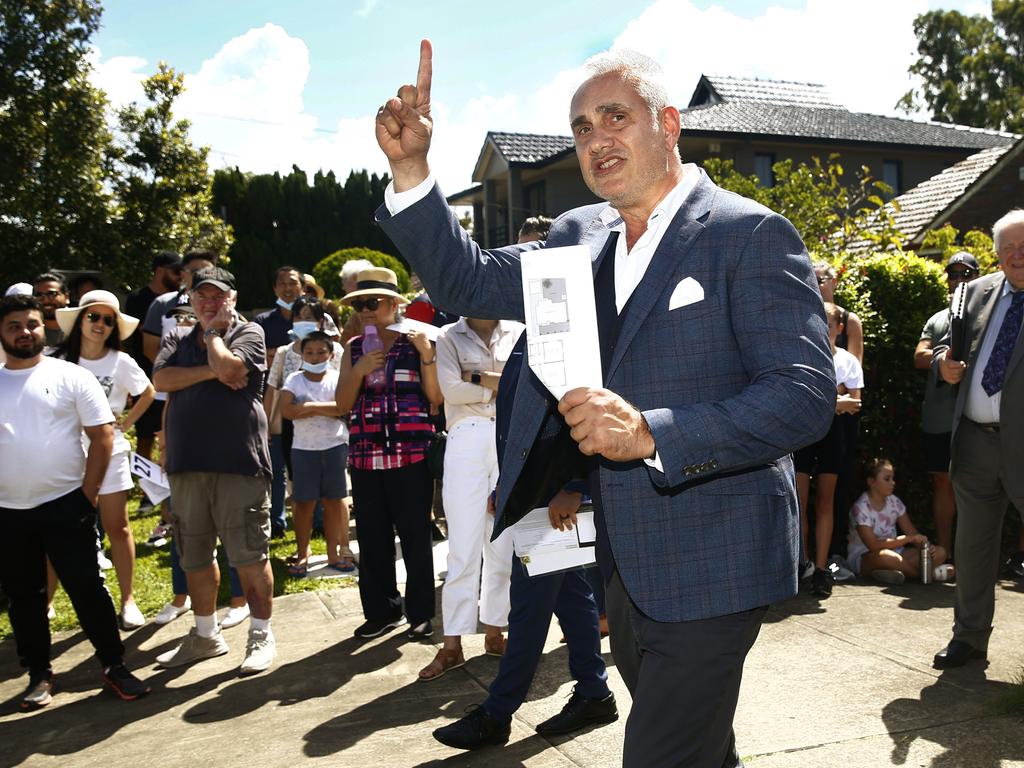‘We’re back, baby!’: Stressed auctioneer says market is ‘settling’ but slams ‘bottom feeders’
A real estate coach who said he was “stressed” after almost no buyers showed up to his auctions has a message for a certain kind of hopeful buyer.
A real estate coach who earlier this month said he was “stressed” after almost no buyers showed up to his auctions has triumphantly declared “we’re back, baby!”, after a successful Saturday of sales he believes shows a “settling of the market”.
“Let me tell you, baby, we’re back,” Tom Panos said in a video update on Saturday afternoon.
“Seven out of ten, and some pretty good prices. This morning I started off and I had zero out of two, and I thought to myself, is this a sign of things to come? And bang, it shifted – did it shift. Strong bidding, some really big results over reserve price.”
But Mr Panos blasted “bottom feeders” offering 50 per cent of the value of the home, declaring that even when the market goes down, “it doesn’t mean a home halves in value”.
The auctioneer had previously called on the Reserve Bank to consider the impact of its aggressive rate hikes on the property market, with prices falling and buyers appearing spooked by sharply rising interest rates.
The RBA has already delivered back-to-back 50 basis point increases in June and July, following a 25 basis point rise in May, taking the official cash rate to 1.35 per cent – and ANZ has warned the cash rate is likely to pass 3 per cent before Christmas.
Last week, RBA deputy governor Michelle Bullock revealed just under 30 per cent of homeowners would struggle to make repayments if rates rise by 3 per cent.
Ms Bullock said homeowners who took advantage of record low fixed rates could be slugged with a 40 per cent increase when they expire.
“Borrowers with fixed-rate loans that are due to expire by the end of 2023 would experience a median increase of around $650 (or 45 per cent) in their monthly repayments,” she told the Economic Society of Australia.
“This is slightly more than the rise in payments that variable-rate borrowers would experience over this time.”
Want a streaming service dedicated to news? Flash lets you stream 25+ news channels in 1 place. New to Flash? Try 1 month free. Offer ends 31 October, 2022 >

Interest rate increases have already caused the “sharpest slowdown in more than 30 years”, according to PropTrack’s June report, which showed national home prices fell 0.25 per cent last month.
But prices in some suburbs have already fallen by up to 30 per cent.
Mr Panos said his results on Saturday meant “it’s clear to me that we might be getting a settling of the market”.
“What actually happens is an acceptance of a new level of pricing in the market, where there’s enough transactions that have taken place and people say, ‘Oh that’s the new values’, and they’re fine about it when they accept it,” he said.
“And the reason they’re fine about it is because they realise, ‘We probably won’t get that dream price for our home, but we’re probably going to find something at a lot lower figure that we were originally forecasting.’”
Mr Panos thanked “the media of Australia who are doing all of the vendor management that’s needed at the moment”.
“Every article that’s appearing is actually helping the marketplace accept reality,” he said.
The “biggest problem”, he said, was the houses that had been on the market for a while.
“Those vendors have not accepted the new market,” he said. “They’re often sort of ruminating, and saying, ‘Oh had I put it on a little bit earlier life would have been so much better.’ The new vendors, they’re coming in, they’re already educated at the time of listing.”
Mr Panos urged real estate agents not to be “rattled” by “opportunistic buyers” offering half the property’s value.
“To every real estate agent out there watching this, be calm and collected at the moment because I know sometimes you’re getting things that end up rattling you,” he said.
“Example, opportunistic buyers, bottom feeders that have heard the market’s changed, and whilst it’s changed 10-15 per cent, some of these buyers that come out of nowhere they’re offering half the price of the value of the home. ‘Oh but the market’s gone down.’ Well when the market goes down, let me tell you, it doesn’t mean a home halves in value.”

Another issue, he said, was vendors suddenly raising the reserve price the day before the auction – which he attributed to “Larry the Liar” real estate agents trying to “sabotage” the sale.
“Occasionally, and it happened to me today, you get the occasional vendor that decides at the last minute they’re going to increase the reserve dramatically – like you’ve got a reserve set on a Friday and then on a Saturday they cross it off and say, ‘We want another $200,000.’”
Mr Panos claimed sometimes an agent that missed out on the listing “throws a bomb the night prior to the auction”.
“They ring up the vendor and say, ‘All the best tomorrow. Hope you have a great result – and by the way, I know there’s going to be buyers [they’re going to be] paying this price.’ So they actually throw a bomb to sabotage the auction by giving a vendor fake expectations on what’s possible,” he said.
“That is a dirty act that some agents do.”
Most economists forecast the cash rate to reach 2.85 per cent by mid-2023, while the futures market is tipping a peak of 3.5 per cent.
That would take the average discount variable mortgage rate to 6.2 per cent or 6.8 per cent, respectively.
Based on the RBA’s own modelling, a cash rate of 2.85 per cent would suggest a peak-to-trough fall in house prices of around 20 per cent, while a 3.5 per cent cash rate would drive prices down 25 per cent.
“Sydney and Melbourne would likely face even bigger price falls than the national average because they are the most expensive housing markets with the most mortgage-indebted households,” MacroBusiness chief economist Leith van Onselen wrote last week.
“Mortgage-holders in our two largest cities better hope neither the economists nor the market is correct, and that the RBA stops well short in its monetary tightening. Otherwise, Sydney and Melbourne are staring at their biggest price corrections in living memory.”
Despite Mr Panos’ observation, Saturday’s preliminary auction clearance rate of 50.7 per cent suggests the market continues to weaken.
Sydney was at 47.6 per cent and Melbourne was at 58.3 per cent, according to PropTrack figures.
“After a brief stabilisation, Sydney clearances appear to have resumed their downswing,” AMP Capital chief economist Shane Oliver wrote on Twitter, noting July clearance rates were typically around 67 per cent.
“Further falls are likely in both cities as rapidly rising mortgage rates impact.”
PropTrack economist Anne Flaherty said more properties were hitting the market than is typically seen over winter.
Nationally, the number of scheduled auctions set to take place this week is 97 per cent higher compared to the same time last year, with the largest rises seen in South Australia, up 188 per cent, NSW, up 127 per cent, and Victoria, up 124 per cent.
“Contributing to the above average number of properties being listed for sale could be the expectation that prices are likely to head further downwards over the coming year, with sellers looking to maximise their gains,” Ms Flaherty said.
“This is good news for current buyers, as the higher volume of listed properties has coincided with a moderation in buyer demand. This is reducing competition among prospective buyers and driving clearance rates lower.”






